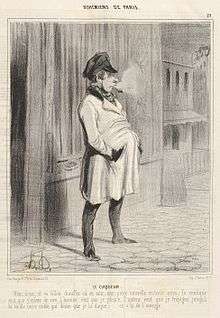Claque
A claque is an organized body of professional applauders in French theatres and opera houses. Members of a claque are called claqueurs.

History
Hiring people to applaud dramatic performances was common in classical times. For example, when the Emperor Nero acted, he had his performance greeted by an encomium chanted by five thousand of his soldiers.[1]
This inspired the 16th-century French poet Jean Daurat to develop the modern claque. Buying a number of tickets for a performance of one of his plays, he gave them away in return for a promise of applause. In 1820 claques underwent serious systematization when an agency in Paris opened to manage and supply claqueurs.
By 1830 the claque had become an institution. The manager of a theatre or opera house was able to send an order for any number of claqueurs. These were usually under a chef de claque (leader of applause), who judged where the efforts of the claqueurs were needed and to initiate the demonstration of approval. This could take several forms. There would be commissaires ("officers/commissioner") who learned the piece by heart and called the attention of their neighbors to its good points between the acts. Rieurs (laughers) laughed loudly at the jokes. Pleureurs (criers), generally women, feigned tears, by holding their handkerchiefs to their eyes. Chatouilleurs (ticklers) kept the audience in a good humor, while bisseurs (encore-ers) simply clapped and cried "Bis! Bis!" to request encores.[1]
The practice spread to Italy (famously at La Scala, Milan), Vienna, London (Covent Garden) and New York (the Metropolitan Opera). Claques were also used as a form of extortion, as singers were commonly contacted by the chef de claque before their debut and forced to pay a fee, in order not to get booed.
The staging of the opera Tannhäuser was withdrawn by its composer, Richard Wagner, from the Parisian operatic repertory after the claque of the Jockey Club derisively interrupted its initial performances.[2][3]
Later Arturo Toscanini and Gustav Mahler discouraged claques, as a part of the development of concert etiquette.
Although the practice mostly died out during the mid to late 20th century, instances of actors paid to applaud at performances still occasionally appear, most famously with the Bolshoi Ballet.[4]
See also
- Astroturfing
- Cheerleading
- Kakegoe
- Laugh track
- ōmukou (ja:大向う) - case of Kabuki
- Payola
- Professional mourning
- Shill
- Social proof
Notes
- "Claque". TheatreHistory.com. Encyclopedia Britannica, 11th edition (1911), Vol. 6, p. 423. 2002. Retrieved 24 January 2017.
- Millington, Barry, ed. (1992). The Wagner compendium : a guide to Wagner's life and music. New York: Schirmer Books. p. 281. ISBN 9780028713595.
- Grey, Thomas S. (2013). "Tannhäuser, Paris scandal of 1861". In Vazsonyi, Nicholas (ed.). The Cambridge Wagner Encyclopedia. Cambridge, England: Cambridge University Press. pp. 581–583. ISBN 9781107004252.
- Barry, Ellen (14 August 2013). "Wild Applause, Secretly Choreographed". The New York Times. Archived from the original on 15 August 2013. Retrieved 22 May 2020.
References
- The Oxford Dictionary of Opera, by John Warrack and Ewan West (1992), 782 pages, ISBN 0-19-869164-5
